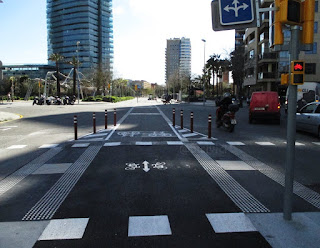In Barcelona, several new two-way bike lanes have been constructed in the central median of avenues. Usually, this design is used in wide two-way streets (at least 20 m wide) with several lanes for cars (or for buses). It's a design that some designers say that is safe for bicycle and car interaction, easy to implement and does not affect much car mobility, but is it really convenient for bikes?
  |
| Design from the bike lane design guide of Barcelona |
Junctions and crossings
The biggest problem of this design solution are junctions and how to manage all the possible turns that each mean of transport might legally do. The worst case scenario may occur when two two-way bike lanes cross each other and at least one of them is a central one.
The central median two-way bike lane is far away from the sidewalks and the perpendicular streets. How does a cyclist turn left or right? There is usually not enough space for the cyclist to wait for the green light and turn. How do cyclists start or end their trips? How do they go to the sidewalk? Do they dismount? Do they have bicycle crossings next tot the pedestrian crossings? Are they allowed to use the car lanes? Will they used them or will the cycle on the sidewalk?
Safety
Another concern is safety. Cycling in the middle of the traffic does not give a safety feeling, but based on facts, staying in the middle of the cars you are doubling your chances of being hit by a car.
The bike lane width, the buffer width and the type of separation used are key elements of this real safety. Enough width will allow cargo bikes to use the bike lane safely, and also, spaces to wait before turning left or right.
It is widely known that in the middle of the streets a higher level of pollutants can be found, and that on the sidewalks, as you move further away, pollutants decrease.
It is not fair that cyclist have to breath the air pollution they do not produce. And considering that cyclists do breath more air (because of their physical activity), this design is specially unfair.
Shade and lightning
It might seem a minor issue, but on hot summer days, it is much more comfortable to ride in the shade than in the sun. This design does not usually has space for trees and because the bike lane is such a far distance from the buildings, the shadows might no reach the bike lane. We might also consider that traffic might rise up temperature into 1.5°C. All in all, cyclist might look for alternative routes on hot days.
Another issue reported in some of these bike lanes, as they are two-way lanes, is the car headlights glare. Also, the ligthning of the bike lane might be problematic as the street lamps are usually on the sidewalks.
Types of central bike lanes
 |
| Roundabout with no bike lane in Cornellà (La Saboga) |
Conclusions
Two-way bike lanes are not the best design and it gets worst when we implement them in the central part of the road because:
- Junctions are much more difficult to design.
- Makes cycling less safe.
- Some cycling itineraries (turns) might be forgotten and the cyclist might have to ride a longer distance.
- More cyclists ride on the sidewalks.
- The design is not convenient for short rides on these streets. On the other hand, with a good green wave, it could be a fast route for cyclist.
- Cyclists might avoid the bike lane on hot summer days.
- Cycling traffic does not interfere with car parking, bus stops or bus lanes, but brings cyclist to the sidewalk.
- It might be cheap to implement when forgetting some essential parts: bicycle signs, bicycle traffic lights for turns, convenient street lamps, etc.
More information:



No comments:
Post a Comment